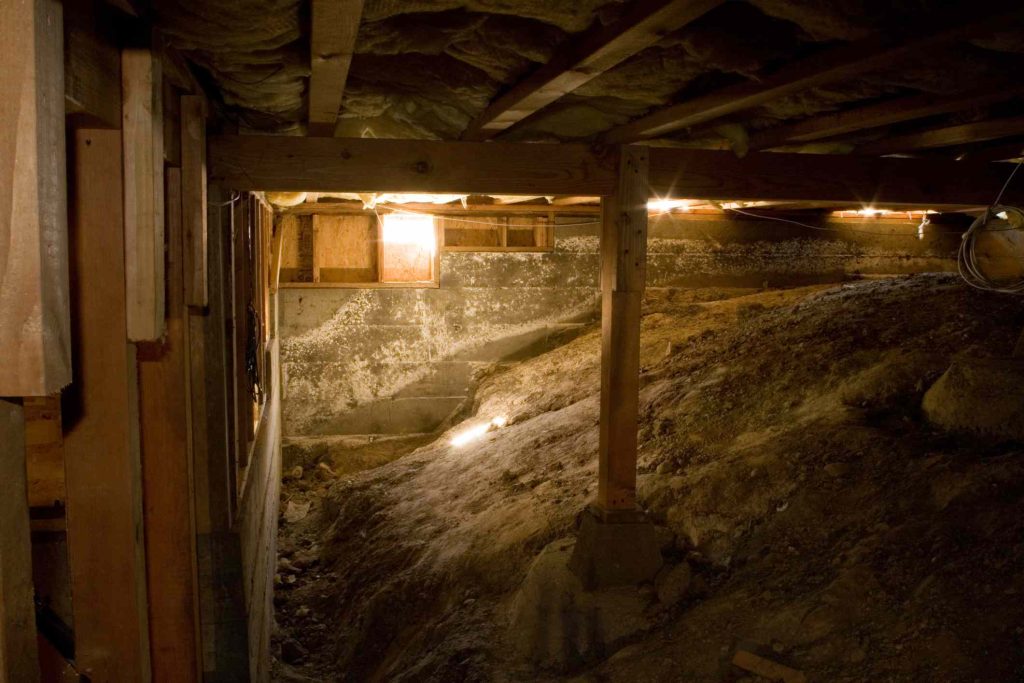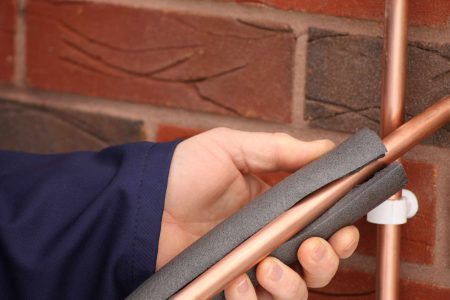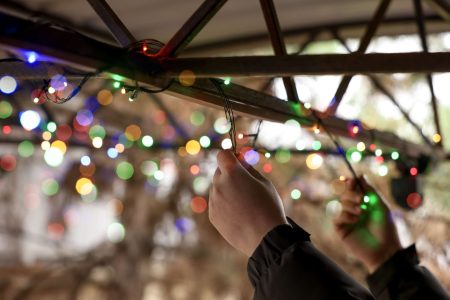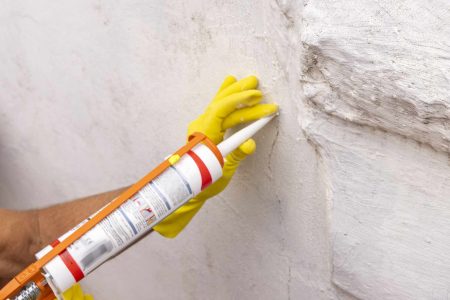You may be familiar with more obvious moisture problems due to damaged roofs and walls or rainwater runoff that seeps into foundations or up through concrete foundation floors. However, crawl spaces are also prone to moisture problems from water vapor that rises from the ground and gets trapped in the enclosed space. Fortunately, you can add plastic sheeting as a water vapor barrier to correct the problem or prevent it from occurring.
What Is a Vapor Barrier?
A vapor barrier slows down ground moisture from affecting a house sitting above it. The barrier is made of rolls of ordinary sheet plastic that are laid down on the ground in a crawl space to trap water in the ground from evaporating or condensing. The U.S. Department of Energy calls a vapor barrier a “vapor diffusion retarder” since plastic sheeting, even with seams sealed, cannot seal off 100% of the moisture.
The plastic sheeting is made of reinforced polyethylene plastic sheeting (poly) in various thicknesses and strengths, usually from 6 mils to 23 mils, depending on your budget and needs. A mil is equal to 0.001 inches of thickness, so a 6-mil sheet is (0.006-inch thick). A 6-mil sheet is considered a Class 1 vapor retarder, which is the minimum recommended thickness when installing a reinforced poly vapor barrier.
Vapor barrier sheeting can cost 15 cents to $1.50 per square foot; the cost variation is based on the thickness of the sheet. For an expert to install, it can run $2,000 to $4,000, depending on the space size and sheet used.
Benefits of Installing a Vapor Barrier
A vapor barrier is a relatively inexpensive remedy to a situation that can get out of control if left unchecked. With so many benefits, installing a vapor barrier in a crawl space seems a great option for homeowners, and it has many distinct advantages:
- Keeps moisture from seeping up through the flooring into your home
- Holds off mold and mildew from growing
- Reduces potential for structural wood rot
- Discourages pests that prefer wet environments
- Prevents wiring mishaps caused by moisture or rust and corrosion of wires and connectors
- Provides extra insulation to improve a home’s energy efficiency
- Gives cleaner, easier access to the crawl space
Problems Caused by Moisture
Moisture is one of the main foes of a home’s structure—potentially causing structural problems. Uncontrolled moisture can cause rot and decay in wood framing and other materials, fostering mold and mildew. Moisture is most damaging in a crawl space because you often can’t see it.
Moisture determines if a home, room addition, or below-grade flooring is even possible. If moisture is a known problem, vapor barriers can be integrated into wall, ceiling, and floor construction to combat moisture affecting the home.
Mold and Mildew
One of the most serious problems caused by moisture is mold, mildew, and other fungi. Eliminating mold is complex, and fully remediating mold-related problems is expensive. Mold can blacken floor cavity insulation and structural elements. Because there is often no light and minimal ventilation in a crawl space, the problem only goes away with preventive measures or remediation.
Rot
Structural elements of your house, such as joists, sills, posts, and beams, are wood. Wood will rot when it comes into contact with water for prolonged periods.
Rodents and Other Vermin
Many types of animals are drawn to water and can invade your home. These pests include carpenter ants, termites, rats, mice, snakes—even skunks and armadillos.
Before You Begin
If done on your own, installing a vapor barrier is not a complicated or expensive project, but it can be hard work because it requires a lot of crawling on hands and knees in a dark, often damp space. A good work light is essential to working safely and efficiently in the cramped space below the house.
While it is possible to do this job by yourself, it helps to have at least one helper to pass items through the crawl space door and to help with rolling out the plastic and taping the seams.
What You’ll Need
Equipment / Tools
- Garden rake
- Portable work light and extension cord
- Utility knife
- Tape measure
Materials
- Trash bags
- 6-mil minimum thickness clear polyethylene plastic
- Double-sided butyl tape
- Poly PVC tape intended for crawl space sheet installation, such as Dow Weathermate Construction Tape
Instructions
How to Install a Vapor Barrier
-
Locate the Crawl Space Entrance
The entry hatch to a crawl space is not always obvious. Sometimes it is located outdoors, along the perimeter wall of the crawl space. In other instances, you will find an indoor entry hatch in a closet, pantry, or utility area. If your floor has wall-to-wall carpeting, look for a square seam in the carpeting that indicates a hatch door.
-
Dry out the Crawl Space
It is best to begin with a crawl space that is as dry as possible. Methods for drying out a crawl space include: using a dehumidifier; setting up fans; removing wet materials, and using a pump to discharge any standing water.
You may need several days of effort to dry out the crawlspace before you venture down to lay vapor barriers over the ground.
-
Clean the Crawl Space
Crawl spaces are notoriously messy, as construction workers often toss discarded building materials in this space. Remove all debris, especially anything sharp that might puncture the plastic. To the degree possible, level out the ground using a garden rake.
-
Roll Out and Cut Plastic Sheets
Beginning at one side of the crawl space, lay down 6-mil or thicker polyethylene plastic over the entire crawl space. Cut the sheets to size, allowing 6 inches or more along walls. Overlap the seams by no less than 12 inches and secure them together with the poly PVC tape.
-
Attach Sheeting to Walls and Piers
With every house, you will encounter both outer support walls or columns and inner support piers and posts. For inner supports, cut the plastic sheeting to fit around them and seal the plastic against the supports using double-sided butyl tape. The goal is to provide a solid barrier against the ground. Where necessary, you can cut additional small pieces of plastic to seal any gaps and ensure a full barrier.
Around the perimeter of the crawlspace, extend the plastic sheeting at least 6 inches up the walls and secure it in place with double-sided butyl tape.
-
Improve Ventilation
Plastic vapor barriers will prevent most water vapor from seeping up from the soil into your crawlspace, but improving cross ventilation through the crawlspace is an important additional method that will prevent any residual moisture from being trapped in the space. Vapor barriers greatly slow the migration of moisture vapor up from the ground, but without cross ventilation through the space, some moisture can still collect.
Most crawl spaces have inadequate ventilation, and bringing the vents up to code can greatly help moisture issues. In more serious cases, an electric vent fan system can help keep a crawl space dry.
Vapor Barriers vs. Crawl Space Encapsulation
A vapor barrier is a retardant, slowing down moisture from doing damage, mainly sealing the ground. Meanwhile, crawl space encapsulation completely seals the entire crawl space, including the walls, in thicker sheeting that is usually 10 mils or more.
The entire area is contained and clean; professional installers do encapsulation. Included in the encapsulation is a dehumidifier and sump pump to drain away any water. Once encapsulated, the space is sealed from water and safe to use as additional storage. This option is the best way to preserve the crawl space and protect the home from moisture, but it is very pricey.
Other Crawl Space Water Seepage Issues
Plastic sheet barriers only contain gaseous water vapor from the soil into the crawl space. They do not offer a remedy when water pools in the crawl space. Pooling water can come from several sources:
- Water table or rainwater runoff: A high water table or precipitation may cause water to pool in the crawlspace. In this case, you will need to hire a water remediation company. In most cases, they will dig a trench around the perimeter, add a drain pipe, cover the pipe with drain gravel, and add a sump pump. In other cases, adding roof gutters and downspouts and reconfiguring the earth grading may be enough to eliminate pooling water.
- Leaky plumbing: Leaking pipes, either water supply or drain pipes, may be causing water to pool up in the crawlspace. Water leaking from damaged pipes above must be fixed before you put down a vapor barrier, or water will pool up on top of the plastic sheeting.
-
What happens if you don’t have a vapor barrier in a crawl space?
If you don’t have a water vapor barrier, your home is at a higher risk of water damage and many preventable potential problems.
-
Does mold grow under a crawl space vapor barrier?
Yes, mold, mildew, and fungus can grow under the vapor barrier. It’s essential to ensure the vapor barrier remains sealed and in good shape so the mold spores don’t infiltrate the crawl space.
-
Why shouldn’t you encapsulate your crawl space?
Encapsulation is a wonderful prospect, especially if you want additional storage space. However, it can be very costly. The initial layout is expensive, including ongoing costs like the continual maintenance costs for the dehumidifier or other systems like the sump pump or other drainage trenches. The encapsulation system will also need a yearly inspection to ensure it remains sealed properly.
Read the full article here









